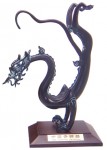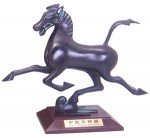Zhouyuan Bronze Museum
Address: Shaanxi Province, Baoji City, Fugang County, Famen Town, Zhaochen Village
Zhaochen Village
Zhouyuan is an ancient region with more than 3,000 years of history. It is located in the western part of the Guanzhong Plain of Shaanxi Province and includes one of the capitals of the early period of the Zhou Dynasty. In history it is known as ‘Qi Zhou.’ The cultural relics both on and below ground are especially rich, and the large quantity of bronzes excavated here are world famous. In 1982, this was declared by the State Council to be a National Important Cultural Relics Protected Unit.
The Zhouyuan Museum (Chinese bronze artworks from Zhouyuan Bronze Museum) was built on the foundation of the excavation of the Zhouyuan site. It was formerly the site of two cultural relics Protection and Management Institutes called Zhouyuan Qishan and Fugang. In 1986 these were combined to become the Zhouyuan Museum which is located in Fugang County, Famen Town, Zhaochen Village. The Zhouyuan Museum’s existing exhibitions are divided into inside and outside components. The outside exhibitions are mainly the Village Ancestral Temple and the Zhaochen Village Palace, a large-scale architectural grouping. These provide a valuable resource for researching Western Zhou architecture and technology, and the political, economic and cultural systems of the court at that time. These fill what had been a void in ancient Chinese architectural history.
The inside exhibitions mainly include the Zhouyuan Excavated Relics Exhibit, the Zhouyuan Historical Cultural Relics Exhibit, Western Zhou Calligraphy and Arts Exhibit, Western Zhou Wine-Culture Exhibit, and the special exhibit at Famensi Temple which is called the Zhouyuan Precious Cultural Relics Special Exhibit. These exhibits display the some 3,000 items excavated at the Zhouyuan site, including bronzes, jades, bone, ceramics, augury tortoise shells, augury bones, and so on. In the exhibition, people c an enjoy bronzes from three thousand years ago such as one that has 284 characters inscribed on the boom of its interior, relating the history of six kings of Western Zhou and the important accomplishments of the currently-in-power seventh king. It also records the family history of the owner of the vessel, providing reliable data for researching Zhou-dynasty history. In the Western Zhou Wine-Culture Exhibition, around one hundred specimens of materials for fermenting alcohol, vessels for fermentation, articles for warming wine, for mixing alcohols and so on are exhibited. China’s earliest ceramic-material architectural tiles are also on display, which date to six to seven hundred years earlier than the Qin bricks and Han tiles of Chinese tradition. In the exhibit people can also see valuable western Zhou jiaguwen or oracle bone inscriptions, which record the relations between Zhou people and the Shang court as well as other countries. In the calligraphy section, examples of western Zhou calligraphy that have been excavated in recent years are on display.
 Dragon is a symbol of the Chinese nation. In history, the dragon of the Chinese nation as a common object of worship, God, art image, communicate a vast land of China from different nationalities, people of different faiths relations, the promotion of the nation’s mutual understanding and unity, the integration of different cultural unity has played a positive role. A long history and colorful culture of DRAGON, in traditional Chinese culture holds an extremely important position, are a symbol of Chinese traditional culture-Chinese bronze artworks.
Dragon is a symbol of the Chinese nation. In history, the dragon of the Chinese nation as a common object of worship, God, art image, communicate a vast land of China from different nationalities, people of different faiths relations, the promotion of the nation’s mutual understanding and unity, the integration of different cultural unity has played a positive role. A long history and colorful culture of DRAGON, in traditional Chinese culture holds an extremely important position, are a symbol of Chinese traditional culture-Chinese bronze artworks.
This bronze sculpture features a Chinese dragon standing on two front legs as if it were diving down in the air. In contrast to western counter part, the Chinese dragon is a snake-like creature has two horns and four claws. This bronze sculpture is an earlier version of the Chinese dragon which has a standout tail and no scales. The replica is well made, the dragon can balance itself with just two front claws on a flat surface.
This small and complex, graceful posture dragon, reflecting the ancient division of the production of master mechanics right, this is for the great collection. More information, please visit here.
 “The galloping horse with right hind foot on a swallow” is a famous cultural relic from the Eastern Han Dynasty (25 ~ 220). It is now the symbol of China tourism.
“The galloping horse with right hind foot on a swallow” is a famous cultural relic from the Eastern Han Dynasty (25 ~ 220). It is now the symbol of China tourism.
The neighing horse is galloping with its tail raised. Three of its hooves are in the air and its hind right hoof treads on a flying swallow which looks back in horror. Chinese ancient artisans combined realism and romanticism, and ingeniously integrated the galloping horse and flying swallow using rich imagination, original concepts and skillful craftsmanship. The romantic image of the swallow sets off the power and strength of the horse, instilling a rich, imaginative experience in viewers. Judging from the sculpture’s accurate balance, the gravity center must have been rigorously calculated. Mechanical analyses indicate that Bronze Galloping Horse finds a center of gravity in the swallow, which gives the statue its stability. Some experts also say this horse statue was used as a guide for finding the perfect steed.
 Qiang Pan (Qiang Plate) _ Chinese Bronze Vessel : Also known as Shi Qiang Pan (Shi Qiang Plate). Qiang is the first name of a person who is to the Western Zhou period, a historical officer of West Zhou.
Qiang Pan (Qiang Plate) _ Chinese Bronze Vessel : Also known as Shi Qiang Pan (Shi Qiang Plate). Qiang is the first name of a person who is to the Western Zhou period, a historical officer of West Zhou.